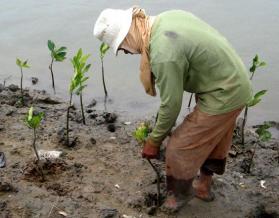 A Pakistan team set the Guinness World Record for tree planting, beating India in an international competition this month. Just 300 volunteers from the local fishing communities planted more than a half million young mangroves in one day, breaking the previous record of 447,874 held by its Indian rivals.
A Pakistan team set the Guinness World Record for tree planting, beating India in an international competition this month. Just 300 volunteers from the local fishing communities planted more than a half million young mangroves in one day, breaking the previous record of 447,874 held by its Indian rivals.
Covered in mud and sweating, the 300 volunteers who have been trained to plant record numbers without using any mechanical equipment, worked all day in a temperature of up to 99° (37°C) before breaking the record some 150 km south east from Karachi.
“It is good to see a productive rivalry between Pakistan and India. We hope that tree planting competitions will become as popular as cricket matches,” said Richard Garstang, the head of WWF Pakistan Wetlands Program.
The mangrove tree planting event was held in the vast wetland ecosystem of the Indus River Delta in the Southern Sindh Province in a unique sanctuary of biodiversity designated as a wetland site of international importance by the Government of Pakistan in 2002.
Mangroves are being cut indiscriminately in Pakistan and other countries for fuel and timber at a very high cost to the environment. Apart from their crucial role in providing habitat for many organisms including fish, shrimps, lobsters, oysters and algae, mangroves also protect the coast from erosion, as well as hurricanes and tsunamis.
Tree planting also creates a special contribution in the global fight against climate change.
Scientists say deforestation contributes to about 20 percent of all carbon dioxide emissions and that reducing deforestation is one of the quickest ways to fight rising temperatures. Forested Wetlands such as mangroves, flooded forests and many peatlands play a crucial role in this respect.
A planting interval of just over 2 m was used in order to give the young Red Mangroves plenty of room to spread their canopies as they grow. Planting was confined to the mudflats of the inter-tidal zone – the area between the high and low tide marks, spread over 803 acres (325 hectares) of the island.
“This is a wonderful example of partnership between government, local communities and the private sector for a common cause, for conservation,” said WWF’s Garstang.



















